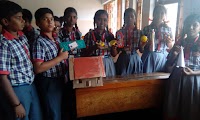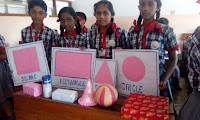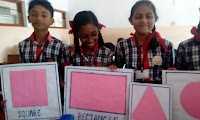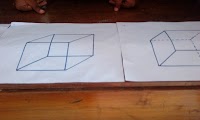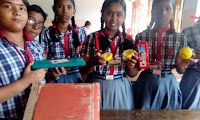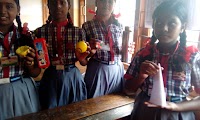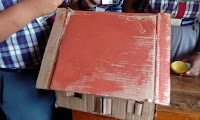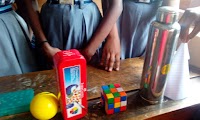SUBJECT : MATHEMATICS
CLASS : 7
TOPIC : VISUALISING SOLID SHAPES
Project Based Learning
1.Project Plan
(1.1)The
Define Phase : Visualising solid
shapes – The net for building 3D shapes & viewing different sections of a
solid
(1.11)Introduction:
·
Write a statement describing the overall
purpose of the project.
·
What is the key challenge or problem the
project is aiming to address?
·
What are students intended to learn from the
project?
The project is intended to allow
students of class 7 to explore the following facts :
(I)
2D
figures & 3D objects
(II)
Faces ,
Edges & Vertices of 3D shapes
(III)
The net
for building 3D shapes
(IV)
Oblique
& Isometric sketches
(V)
Viewing
of different sections of a solid in different ways
(a) Cross section – Slicing /
cutting
(b) Shadows
(c) Front / Side /Top views
|
(1.12)Project
Scope:
Describe the scope of your
project. This may include class and section, subjects it covers, self shills to
be used etc. as well as other factors affecting scope.
Students of class 7
Subject : Mathematics
Students differentiate between 2D
figures & 3D shapes ; get acquainted with the number of faces , edges
& verticesof 3D shapes ; gain knowledge about the net for building 3D
shapes ; be able to understand what oblique & Isomeric sketches are &
be able to view objects in different ways & demonstrate the same
|
(1.13) Curriculum
and Standards:
List the curriculum and
standards this project with cover.
–
Class 7
Mathematics
–
Visualising
Solid Shapes
|
Lesson 2
2.1 Essential
Question:
Put in writing the question that will engage the students
Differentiate between 2D figures & 3D objects
How to form 3D objects
Faces, Edges & Vertices of solid shapes
How to visualise 3D objects
|
2.2 Grouping
Strategy:
Describe the criteria that
will be used to form students team and how this maps to the goals of the
project.
The students of class 7 B are divided into six groups with 9 members
in each group. They discuss , interact with each other , prepare PPT &
models required for the presentation. All their ideas are put together as a
team presentation
|
2.3 Learning
Environment:
Describe the learning
environment for the project including any classroom adaptation that will be
required.
Different figures & shapes are
given for differentiating as 2D & 3D
, different ways of viewing solids used in daily life situations is
put forward , so that students analyse the need & acquire knowledge on
the topic
|
2.4Assessment
Approach:
Describe
the approach for:
2.41 Authentic Assessment:
--
Use of models/ net for building the 3D shapes
-- PPT to demonstrate Isometric &
Oblique sketches / Faces , Vertices & Edges of solids / Shadows of
objects
-- Shadow play
-- Objects to demonstrate the front /
side & top views
|
2.42 Formative Assessment:
Feedback from students will be
collected
|
Assessment done using questionnaire
|
2.43 Summative
Assessment:
2.44 Rubrics:
|
2.45 Gradings:
Grades are allotted for each task
& assessed cumilatively
|
Project Based Learning
Sample – Lesson 3
Plan Phase
3.1 Work
Breakdown, Products and Milestones:
List the project task
and, if possible at this stage include the sub-tasks. For each task add the
product that will be created and indicate it will be a milestone.
Project task : “
Visualising Solid Shapes”
Sub tasks : (i)
Introduction to solid shapes
(ii)
Differentiate between 2D & 3D
(iii) Explain
what are faces/edges/vertices of 3D
(iv) applying the
concept of faces/edges/vertices to find the number of faces/edges&
vertices different 3D shapes posses
(v) Analyse the
net for building 3D shapes & make the net
(vi) Analyse the
difference between Oblique & Isometric sketches
(vii) activity to
view different sections of a solid in different ways
(a) Cross
section – slicing / cutting
(b) Shadow
Play
(c) Front/side/top
views
(viii) PPT on
related topics
(ix) Research –
NCERT class 7 Text book, Internet , Library
|
3.2 Role
definition:
List the roles team members
will fulfill in the project.
Project Leader : Teacher In
Charge – Mrs. MANJU S NAIR
Project Co- Ordinators : AYSWARIA GOPAN, BHAVANA,VISMAY NAIR,ANJANA
PRIYA,TEERTHA RAJ V & RISHABH S
|
3.3 Task
schedule:
Note start and end dates for
the project.
Include
expected dates to start specific tasks
Starting Date : 07.11.2016
Finishing Date : 02.12.2016
|
3.4Special
Activities Plan:
List any
special activities (e.g. Field trips or guest speakers) including dates.
(i)
Activities
-- (a) To show net for building 3D
shapes (b) Viewing different sections
of a solid in different ways
(ii)
Exhibition on
the models prepared for the project execution
|
3.5Resource
Plan:
List resource that will be required
during the project and any other date constraints associated with them.
Resource: Models , PPT , Internet
,Library NCERT Text book
|
3.6 Direct
Instruction:
List any planned direct instruction
sessions and link them to specific tasks if appropriate.
Class session for introducing the topic , demonstration of activities
related to the topic , briefing of project execution
|
3.7 Reviews
and checkpoints:
Describe
how you will incorporate review meetings and checkpoints in the project
Review meetings will be done weekly once , where a report by the
group leader will be presented on the progress of the work assigned to them
|
3.8 Assessment
plan:
Describe the balanced
assessment plan for the project. List products that will be assessed during the
project. List rubrics that need to be created before project launch.
|
Prepare
work plan in the format given below.
Sl No:
|
Task
|
Sub Task
|
Role
|
Starting Date
|
Ending Date
|
Product
|
1
|
Launch Project
|
07.11.16
|
07.11.16
|
Project launched
|
||
2
|
Deliver classroom instruction
|
Defining the project
|
Teacher
|
07.11.16
|
07.11.16
|
Instruction regarding the doing of the project given
|
3
|
Group Selection
|
Selection of group leaders & members
|
Teacher
|
07.11.16
|
07.11.16
|
Group division / group leader selection completed
|
4
|
Content preparation
|
Introduction to the topic
Net for building 3D
Views of objects in different ways
|
Student
|
08.11.16
|
18.11.16
|
Students prepre the content for presentation of project
|
5
|
PPT
|
Preparation of PPT relevant to the topic presentation
|
Student
|
18.11.16
|
22.11.16
|
PPT for topics prepared
|
6
|
Preparation of questionnaire
|
Prepare questionnaire from self
analisation & peer group
|
Each member
|
22.11.16
|
24.11.16
|
Questions prepared
|
7
|
Project presentation
|
Presentation of project with PPT & models
|
Student
|
25.11.16
|
02.12.16
|
Project presented
|
8
|
Assessment
|
Prepare Rubrics for assessment
|
Teacher
|
25.11.16
|
02.12.16
|
Rubrics prepared & assessment done
|
9
|
Exhibition
|
Conduct exhibition of the models and other materials used for the
project presentation
|
Students
|
02.12.16
|
02.1.16
|
Exhibition conducted
|
10
|
Reflection
|
Reflection by peer group
|
Student
|
05.12.16
|
05.12.16
|
Peer groups gave reflections of each group
|
11
|
Project submission
|
To the blog
|
Teacher
|
05.12.16
|
Presentation will be done
|
(5.1) Project Launch:
Describe
how the project will be launched, including how goals, expectation, rules,
procedures, assessment, and grading will be presented to the students.
The project will be launched in class 7B after
explaining the concept that is to be dealt with. The goal of the project is
to explore the concept through activities. Hands on activities along with PPT
& explanations transform the content to concrete base for learning the
concept. It is expected that the students develop a positive attitude &
aptitude towards the subject. Assessment is done according to the Rubrics
given.
|
(5.2) Artifacts:
List artifacts that will be created during the project
(i)
Starting off session: Differentiate between
2D/3D
(ii)
Planning the project: Discussion on the
relevant sib topics for the topic “ Visualising Solid Shapes”
(iii)
Group Selection: Selection of group leaders
& division of sub tasks for the members
(iv)
Description log: To be maintained
(v)
Review meeting reports to be maintained
(vi)
PPT: Presentation on relevant topics
|
(5.3) Culminating product: Describe
what culminating product or products are expected to be created during the
project and how they will be presented.
·
Understand the basic difference between 2D
figures & 3D objects
·
Gain knowledge about the net for building 3D
shapes
·
Understand the number of faces,edges&
vertices of different 3D objects
·
Understand what Isometric & Oblique
sketches are
·
To be able to view objects in different ways
& demonstrate the same
·
Preparation of PPT
·
Preparation of models
|
Project Plan - Lesson 6
The Review Phase (6.1)Student
Reflection and Evaluation:
Describe how student reflection and evaluation will
be conducted.
Reflection of
students to:
·
Allow them
to see the significance of their own learning process/ technique
·
Identify
the areas of strength,short comings , necessary additions & deletions
·
Bring
about strategies to rectify the short comings
·
Motivate
students to make learning a better experience than before
·
Analyse
the need to learn these concepts
·
Apply
the concepts learnt in real life situations
·
Think
critically
Student reflection at 4 levels: Reflection questionnaire
(a)
Before
learning
(i)
Level of
awareness of the topic before the start of the project
(ii)
Has
there been any improvement?
(iii)
If not
in which ways do you think you need to improve?
(iv)
What
type of resource is used for the completion of the project?
(b)
While
learning
(i)
Your
perception about the project
(ii)
Which
groups presentation did you like the best?
(iii)
Dislike
for any presentation? , if so explain why?
( c) After learning
(i)
Whether
the standards of the project is achieved? If not explain the short comings
(ii)
If you
were the teacher , what comments would you give for the presentations?
(iii)
Explain
whether a third person would understand your presentation? & what would
be their perception about you?
(d ) Student moving forward
(i)
Give one
aspect where you can improve upon
(ii)
If given
one more chance to do the work, enumerate the changes that would be
implemented
(iii)
Enumerate
your qualities that you want your teacher to know about you
|
(6.2) Teacher
Reflection and Evaluation: Describe
how teacher reflection and evaluation will be conducted.
Valuing reflection:
Teacher helps the students to moniter their progress
Setting the tone of
reflection: Teacher helps the students
to ask questions themselves of their learning outcomes from the project ;
whether they have achieved the required learning outcome?
Guiding the students:
Teacher guides the student reflection by discussion & questionnaire
Modeling reflection:
Teacher provides role models from history & immediate suroundings
Evaluation: Documents
the reflections of students in depth
with specific reference to learning process , Providing examples , making
integrated learning , Discussing modifications needed
|
(6.3) Assessment
of 21st Century skills: List of 21st century skills in this project and its
assessment
·
Comparison
of information from different sources
·
Drawing
conclusions from information gathered
·
Critical
thinking of the concept
·
Answering
questions needing explanations
·
Feedback for
the assessment of work done by peer group
·
Transferring
of ideas through PPT , reports , videos etc
·
Answering
relevant questions in front of audience
·
Generate
own ideas
·
Team
work
·
Creativity
& confronting new challenges
|
– Lesson 7
The Manage Phase
(7.1) Process Management: List tasks that will be used to manage the process of conducting the
learning
·
The starter questions to draw
attention of students to specific contents of learning task
·
Forming groups with leaders ,
Set goals for the work , Brief the goals & go for next step
·
Once the plan is set ,
instruction can be given at each step for the implementation of the project
·
Students are given power to explain
& teach the content
·
Formative assessment of work
ensuring accountability & feed back for improvement on short comings
·
Time management
·
Check on the track of process
, not allowing to deviate from the intended one , by asking the driving
question frequently
·
Keep a checklist of the
required achievement
·
Use of social media
|
(7.2) Student Preparation: Describe
how students will be prepared for the project prior to launch. List any
specific instruction or tasks that will be needed
·
The
starter question would trigger curiosity among the students on the content to
be learnt
·
By
generating questions , would help to carry forward the project
·
Built a positive stroke in students so that they
have a feeling that “ I can do “ & hence create a positive attitude &
aptitude towards the subject
|
(7.3) Facilitation: Describe how facilitation of resources will be
used to enable the students to be successful.
NCERT Maths text book class 7 &6 ,Library , internet , Advice from
subject experts
|
(7.4) Progress Monitoring: Describe
how program will be monitored throughout the project.
Review report by groups once in a week
|
·
Review report by Group
leaders
·
Formative assessment to check
specific tasks of students
·
Parameters in rubrics to
check team work , coordination , leadership etc
|
Group Progress
Individual Progress
Formative
assessment , teacher / student reflections to discuss the outcomes
|
(7.5) Re-planning: Describe
how‘re-planning’ will be used if the project goes off track
·
Make sure that each group
presents the topic assigned very briefly
·
Check day wise progress of
work to see that they do not go off track
·
Review meetings with group
leaders
·
Check on time management
|
(7.6) Conflict Management: Describe
how to address problems related to participation, offer approaches to manage
other conflicts that may arise.
·
See that each member of the
group is assigned some work to be presented before the audience
·
Involvement of all students
to be monitored , it may otherwise affect the desired outcome
·
Group leaders not to act
single handed , help others & should adjust with other member
|
PHOTOS OF THE EXHIBITION CONDUCTED
